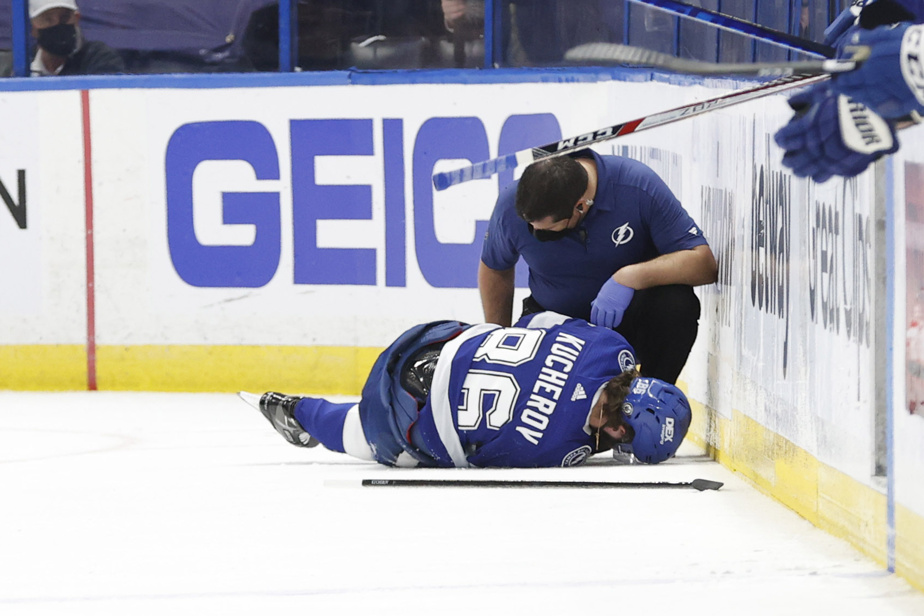Analyze injuries
Are there any pro teams that have an injury analyst position? I’m not talking about the treatment or the fitness protocol, but about determining all the factors that contributed to the injury, including equipment and technical errors.
Yvon Veilleux
Response from Guillaume Lefrancois
This title doesn’t seem to exist in these terms per se, but injury prevention generally ends up in the jurisdiction of “sports science”, an umbrella term that organizations are increasingly using. At the Canadian, Adam Douglas bears the title of “director – sport science and performance”. According to the team, he has a bachelor’s degree in physical education and health, a master’s degree in kinesiology and exercise science, and a doctorate in philosophy, kinesiology and exercise science. That said, like everything related to the medical field and science, teams are generally stingy with details about their initiatives and they will not shout their ideas from the rooftops!
The late check

PHOTO ADAM HUNGER, ASSOCIATED PRESS ARCHIVES
Jacob Trouba’s check against Timo Meier during the Devils-Rangers series
Checking aims to remove the puck from a player. When he no longer has it in his possession, he should no longer be hit. We often see late checks to “punish” an opponent Couldn’t we apply a stricter rule?
Jean-Francois L’Heureux
Response from Guillaume Lefrancois
Article 56.1 of the NHL rulebook states that “the last player to touch the puck, other than the goaltender, is considered to be in possession of the puck. This player can therefore be legally tackled, provided that the check is applied immediately after the loss of possession. You will have understood that the word “immediately” is at the discretion of the referees. However, your proposed change would not prevent hard-hitting hits like Jacob Trouba’s against Timo Meier during the Devils-Rangers series. This check was ruled legal, Trouba did not aim for the head or extend the elbow and Meier was in possession of the puck. But Meier was injured nonetheless. If the goal is to protect the players, there is indeed a reflection to be carried out.
The small amount of fines

PHOTO STEPHEN R. SYLVANIE, USA TODAY SPORTS ARCHIVES
Mattias Ekholm
When the NHL’s Department of Player Safety levies fines of $3,000 to $5,000 (cross-checking, slashing, etc.) on multi-million earning players, the league is covered in ridicule. Would it be relevant to add a 0 to the amount of the fines?
Rui-Jose Serrat
Response from Guillaume Lefrancois
The league can impose fines of up to 50% of a player’s daily salary (1/195 of their annual salary), up to a maximum of $10,000 for a first offense. However, for any fine over $5,000, a player is entitled to a telephone hearing. It is therefore easier for all parties involved to stick to the fine of $5,000. These amounts are provided for in the collective agreement that binds the players to the owners. For higher fines, the league will have to tackle them when this agreement expires (in 2026). However, as in any negotiation, you have to ask yourself if the league cares enough to make a compromise on another point. To ask the question is to answer it, especially since the money from the fines goes to the players’ emergency fund and not to the league.
The Stanley Cup in Canada

PHOTO GEOFF BURKE, USA TODAY SPORTS ARCHIVES
Gabriel Landeskog lifts the Stanley Cup on June 26, 2022 following the Colorado Avalanche’s victory in the Grand Finals.
Since the introduction of the salary cap in the NHL in 2005-2006, none of the seven Canadian teams have won the Stanley Cup, which is 0 in 17 seasons. Is this a statistical anomaly, or simply the law of sport?
Marco DeRosa
Response from Simon-Olivier Lorange
I think what you call the “law of sport” is the best answer. In fact, four teams (Chicago, Pittsburgh, Tampa and Los Angeles) have shared 10 of the last 17 Stanley Cups. And six teams (add Boston and Detroit to the list) shared 17 of the 34 Finals berths. It can therefore be said that, statistically, the Canadian teams were under-represented, but there are nevertheless more American teams (14) than Canadian teams (7) which did not lift the trophy. Remember also that the Edmonton Oilers, in 2006, pushed the Carolina Hurricanes to the seventh game in the final. The Ottawa Senators also lost in the Finals the following season.
Carey Price’s contract, the sequel

PHOTO FRANÇOIS ROY, LA PRESSE ARCHIVES
Carey Price
Why do we often hear that the Canadian must get rid of Carey Price’s contract? As I understand it, this one does not count on the payroll. It is therefore not a burden that the club must absorb and which is detrimental to the signing of players.
Jean-Pier Dutil
Response from Simon-Olivier Lorange
All players’ contracts count towards a club’s wage bill. However, when a player’s name is placed on the long-term injured list, that team’s cap is raised by a certain amount, calculated from the value of the subtracted contract and the space available under the ceiling – yes, it’s complicated. This is why it is often a question of optimization: to get the most available space, you have to spend as much as possible, otherwise you will lose additional space. Back to Price: as he earns very expensive (10.5 million), you have to spend a lot of money to match his salary and get the maximum wage space. This is what prompted the Canadian to acquire Sean Monahan last year. This approach also has disadvantages, in particular the deferral of performance bonuses to the following season.
